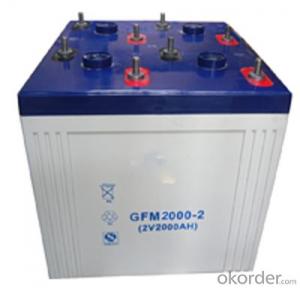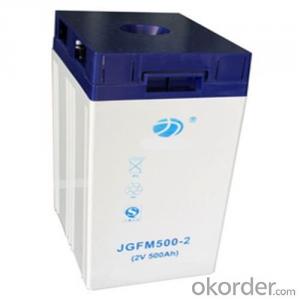Nanostructured Solar Cells Compatible Lead-Acid Battery GFM Series 2V 100~3000AH
- Loading Port:
- China main port
- Payment Terms:
- TT OR LC
- Min Order Qty:
- 1 pc
- Supply Capability:
- 100000 pc/month
OKorder Service Pledge
OKorder Financial Service
You Might Also Like
Structure of Product Descrtption:
What is the product?
· Precision explosion relief valve shall be adopted
· Advanced wrapping technology and assembly technology
· Designed life is fifteen years,excellent performance of battery in low temperature and superiority in consistence and stability
· Can be used at vertical or horizontal orientation
· Balanced design for both floating and cyclic operation
· Low self-discharge rate and long shelf life
· Connecting terminal adopts stainless steel bolt,thus it has the characteristics of high strength and non-deforming
· Design with patented corrosion resisting alloy and thickened plate
What is the purpose of the product?
· Data Centre (High Rate UPS)
· Telecommunication
· Banks & Financial Centre
· Hospital& Testing Laboratories
· Power Generation Plants
· High Power Backup Supply
· Design with patented corrosion resisting alloy and thickened plate
What advantages do products have ?
· Stable quality&high reliability
· Sealed construction
· Environmentally friendly
· Maintenance-free operation
· Low pressure venting system
· Heavy duty grid
· Low self discharge
Main feature of the product:
*safety and reliable
*environmental friendly and fast delivery
*low self diacharge


FAQ:
*Question:What’s price per watt?
Answer: It’s depends on the quantity, delivery date and payment terms of the order. We can talk further about the detail price issue. Our products is high quality with lower price level.
*Question:Can you do FOB for us?
Answer:Yes, we can do it for you .
*Question: How long can we receive the product after purchase?
Answer:In the purchase of product within three working days, We will arrange the factory delivery as soon as possible. The perfect time of receiving is related to the state and position of customers. Commonly 7 to 10 working days can be served.
- Q: Can solar cells be used in powering electric boats?
- Yes, solar cells can be used to power electric boats. Solar panels can be installed on the boat's surface to capture sunlight and convert it into electricity, which can then be used to power the boat's electric motor and other electrical systems. This enables the boat to operate without relying on traditional fuel sources, making it a more environmentally friendly and sustainable option.
- Q: How do solar cells perform in high-pollution areas?
- Solar cells perform less efficiently in high-pollution areas due to the reduced amount of sunlight reaching the cells. The presence of pollutants in the air, such as smog or dust, can block and scatter sunlight, thereby decreasing the overall energy output of the solar cells. Regular cleaning and maintenance of the panels can help mitigate the impact of pollution on their performance.
- Q: Can solar cells be used in electric bikes or scooters?
- Yes, solar cells can be used in electric bikes or scooters. By integrating solar panels onto the vehicle's surface, they can capture sunlight and convert it into electricity to charge the battery. This can help extend the range of the electric bike or scooter and reduce the reliance on grid-based charging. However, the amount of energy generated by the solar cells may be limited, so it may not fully replace the need for traditional charging methods.
- Q: Can solar cells be used to power remote data collection systems?
- Yes, solar cells can be used to power remote data collection systems. Solar cells convert sunlight into electricity, providing a sustainable and reliable source of power for off-grid locations. This makes them ideal for powering remote data collection systems, allowing continuous operation without the need for a grid connection or frequent battery replacements.
- Q: What is the accurate explanation for the sun solar cell power system? How does it work?
- The sun solar cell Power supply system is composed of solar cell module, storage battery and monitoring device.
- Q: What is the role of maximum power point tracking in solar cell systems?
- The role of maximum power point tracking (MPPT) in solar cell systems is to optimize the energy output of the solar cells. It does this by continuously adjusting the operating voltage and current of the solar cells to find the maximum power point, where the solar cells are operating at their highest efficiency. MPPT ensures that the solar cells are always delivering the maximum amount of power to the system, resulting in improved energy generation and increased overall system performance.
- Q: How about the solar cell 156mm Mono-Crystalline?
- Solar Cell measure by 156mm is cut based on the special requirements for certain kind of use, but I am not sure what it is used for.
- Q: Can solar cells be used in oil and gas exploration?
- Yes, solar cells can be utilized in oil and gas exploration. While they may not directly contribute to the exploration process, solar cells can be employed in supporting infrastructure and operations. Solar-powered equipment such as remote monitoring systems, communication devices, and data collection instruments can be used in remote or off-grid locations, enhancing efficiency, reducing reliance on fossil fuels, and minimizing environmental impact.
- Q: What is the impact of solar cells on job creation?
- The impact of solar cells on job creation is significant. The solar industry has seen a rapid growth in recent years, leading to a surge in job opportunities. Solar cell manufacturing, installation, maintenance, and research and development have all created a wide range of employment opportunities. This growth has not only created jobs in the renewable energy sector but has also generated indirect employment in related industries. Additionally, the shift towards solar energy has encouraged innovation and entrepreneurship, further contributing to job creation. Overall, solar cells have had a positive impact on job creation by driving economic growth and fostering a sustainable workforce.
- Q: How does the size of a solar cell affect its performance?
- The size of a solar cell directly affects its performance. Generally, larger solar cells have the ability to generate more electricity compared to smaller ones. This is because larger cells have a greater surface area to capture sunlight, resulting in a higher conversion efficiency and increased power output. Additionally, larger cells are better at handling heat dissipation, which can improve their overall performance and durability.
Send your message to us
Nanostructured Solar Cells Compatible Lead-Acid Battery GFM Series 2V 100~3000AH
- Loading Port:
- China main port
- Payment Terms:
- TT OR LC
- Min Order Qty:
- 1 pc
- Supply Capability:
- 100000 pc/month
OKorder Service Pledge
OKorder Financial Service
Similar products
Hot products
Hot Searches
Related keywords




























